List of endangered animals with pictures and facts, plus links to further information. Test YOUR knowledge of endangered animals with two FREE printable worksheets.
Endangered Animals
Examples of endangered animals include mammals such as the tiger, chimpanzee, Asian elephant and sea otter; birds such as the Egyptian vulture and Galápagos penguin; reptiles such as the Alabama red-bellied cooter and green sea turtle; fish such as the humphead wrasse and whale shark; and amphibians such as the golden poison frog and Majorcan midwife toad.
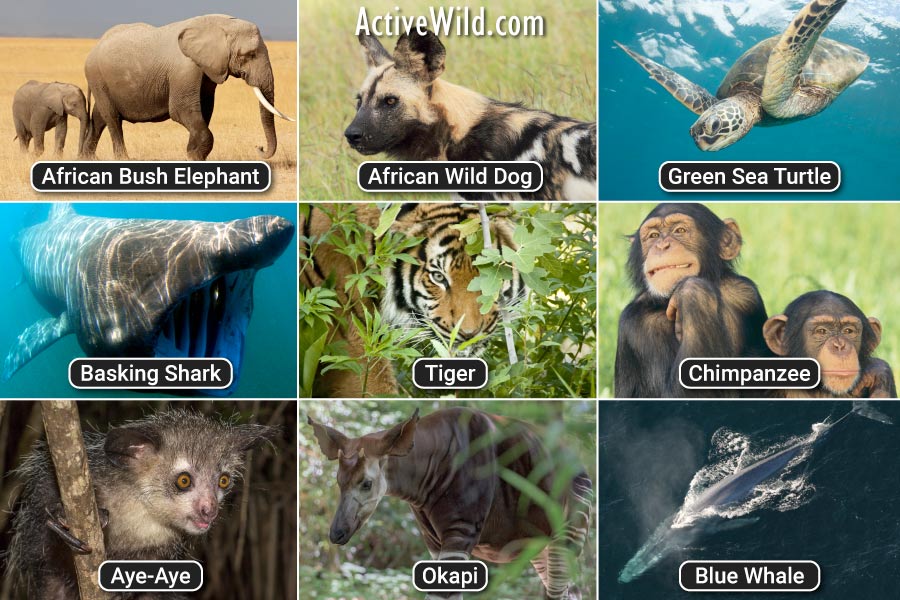
On this page is a list of endangered animals, with pictures and facts on each species. Note: the list below is NOT definitive and contains just a fraction of the world’s endangered animals.
All of the animals on the list below are currently (as of Jan 2023) listed as “Endangered” by the International Union for Conservation of Nature. (Website)
The IUCN has a separate category, Critically Endangered, for the world’s most endangered animals. You can see a list of critically endangered animals on this page: Critically Endangered Species 2022: List with Pictures & Facts
Endangered Animals Printable Worksheets PDF Download
Test your knowledge of endangered animals with these FREE printable pdf question sheets. (No sign-up required; just click, download & print.)
Animal Index
Endangered Animals List 2023
African Bush Elephant
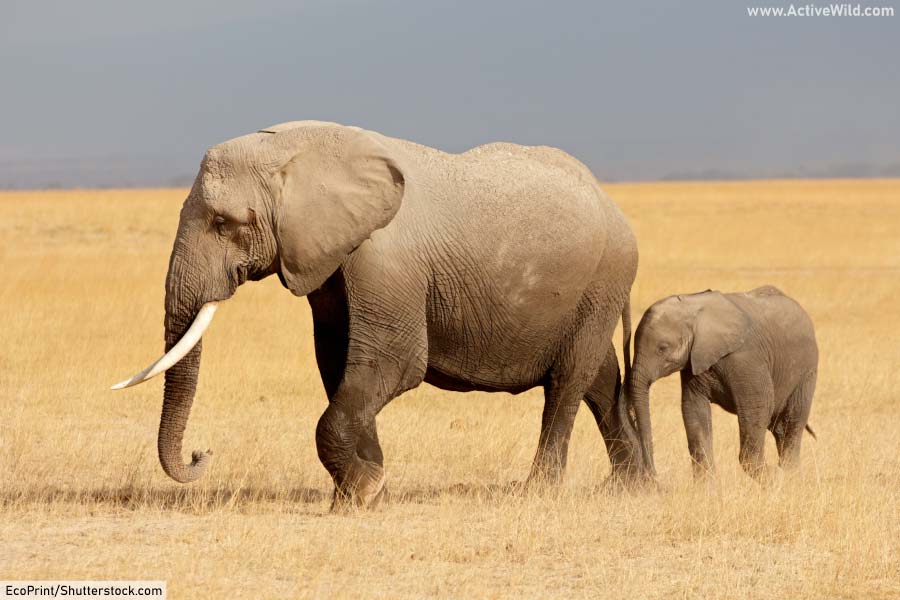
- Scientific name: Loxodonta Africana
- Type of animal: Mammal
- Where found: Africa
The African bush elephant (also known as the African savanna elephant) is the world’s largest living land animal. Large males can weigh up to 10.4 metric tonnes / 11.46 short tons (22,928.08 lb.).
Both male and female African bush elephants have tusks, which are teeth that project out of the mouth.
Why are African bush elephants endangered?
The African bush elephant’s endangered status is due mainly to illegal poaching for their valuable ivory tusks, together with loss of their natural habitat.
African Spurred Tortoise
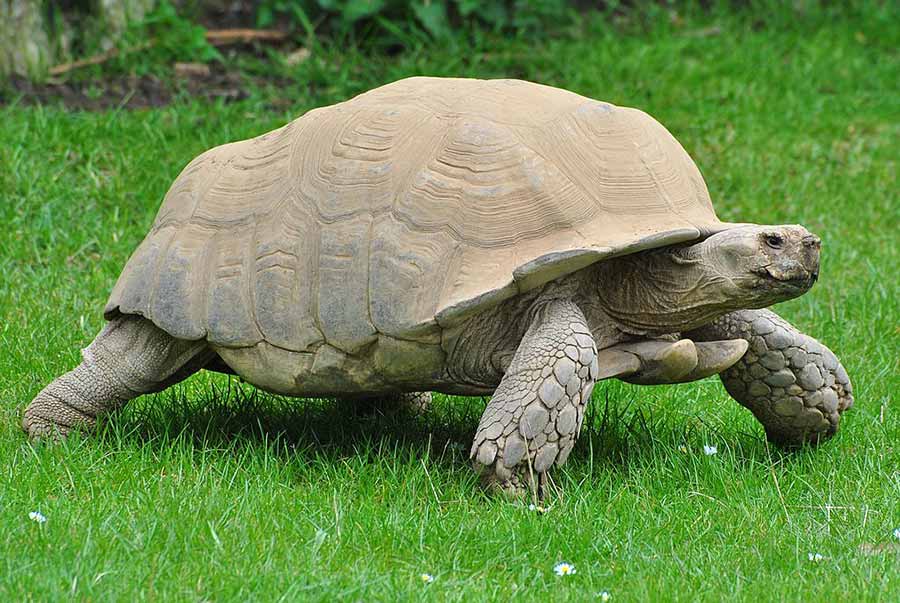
- Scientific name: Centrochelys sulcata
- Type of animal: Reptile
- Where found: Africa
The African spurred tortoise is the third-largest type of tortoise in the world, and the largest found on the mainland; only the Galapagos tortoises and the Aldabran tortoise are larger (these tortoises are found on islands).
The African spurred tortoise can reach lengths of 83 cm (33 in) and weights of 105 kg (231 lb.). It is found in the Sahara Desert and the Sahel; a dry grassland / savanna region that stretches across Africa from Mauritania in the west to Ethiopia and Eritrea in the east.
Why are African spurred tortoises endangered?
Primary causes for the African spurred tortoise’s endangered status are habitat loss (due to farming and bush fires), capture for the pet trade, and being hunted for meat.
African Wild Dog
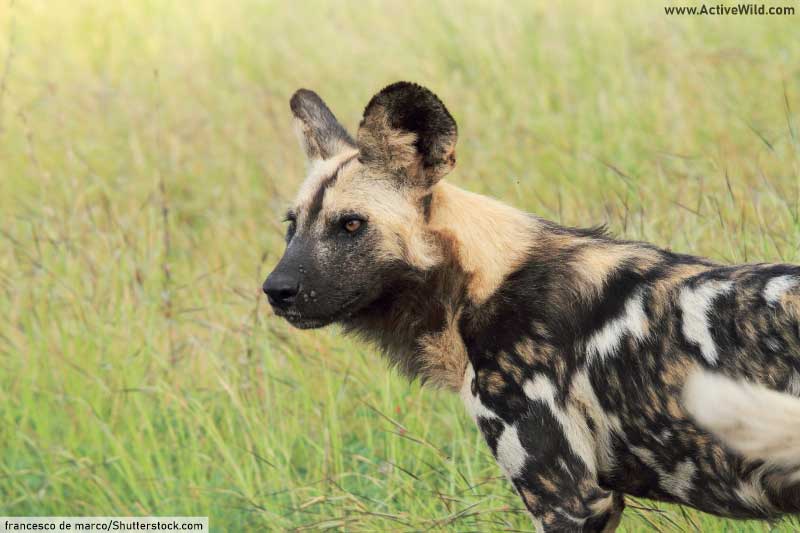
- Scientific name: Lycaon pictus
- Type of animal: Mammal
- Where found: Africa
African wild dogs are found in Sub-Saharan Africa (the part of Africa south of the Sahara Desert). These endangered canids live in packs consisting of an alpha pair and their offspring. They hunt at dawn and dusk, pursuing prey such as Thomson’s gazelles and other mid-sized antelopes.
The African wild dog is easily identified due to its patterned coat, which gives the species its alternative name of African Painted Dog.
It is estimated that fewer than 1,500 adult individual African wild dogs are left in the wild. The species’ population is fragmented over a wide area.
Why are African wild dogs endangered?
The biggest threat to the African wild dog is habitat loss. This is a species that needs a lot of space; a growing human population in the dogs’ natural habitat restricts the area in which it can hunt.
Alabama Red-Bellied Cooter
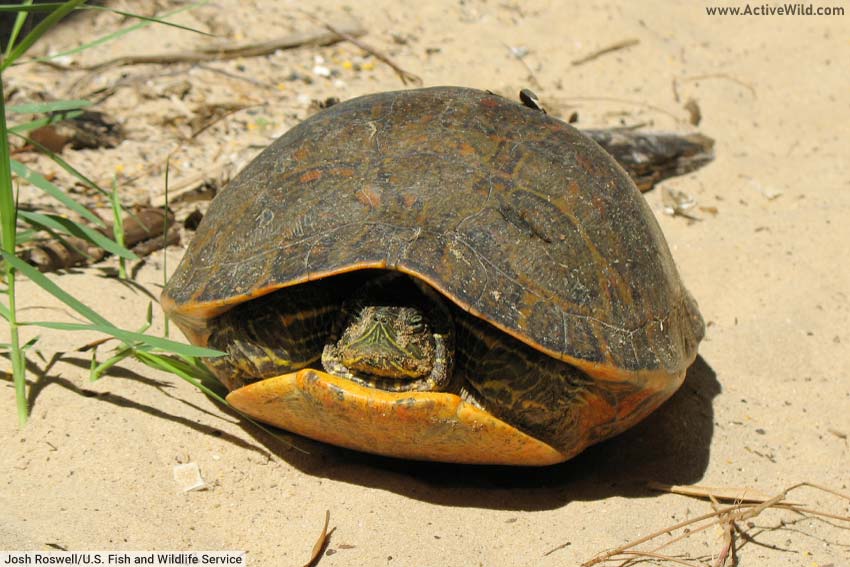
- Scientific name: Pseudemys alabamensis
- Type of animal: Reptile
- Where found: North America
The Alabama red-bellied cooter is a species of turtle found in Alabama’s Mobile–Tensaw River Delta, a 260,000 acre wetland region. The species is Alabama’s official state reptile.
The Alabama red-bellied cooter grows up to 1 ft. / 30 cm in length and its plastron (the shell covering the turtle’s undersides) is orange in color (hence the species’ name).
This endangered reptile belongs to the family Emydidae, whose members are also known as “pond turtles” or “terrapins”.
Why are Alabama red-bellied cooters endangered?
Alabama red-bellied cooters are endangered primarily due to habitat loss and illegal capture for sale to the pet trade. They can also become trapped and drown in fishing nets and crab pots.
Amazon River Dolphin / Boto

- Scientific Name: Inia geoffrensis
- Type of Animal: Mammal
- Family: Iniidae
The Amazon river dolphin, also known as the boto or pink river dolphin, is the largest river dolphin species. It is found in the Amazon River and its tributaries.
As an Amazon river dolphin matures, its skin changes from gray to pink in color, resulting in the species’ alternative name of “pink river dolphin”.
The Amazon river dolphin is closely related to the Bolivian, Orinoco and Araguaian river dolphins (all of which are found in South America); some scientists consider some or all of these dolphins to be subspecies of the Amazon river dolphin, rather than separate species.
Why Are Amazon River Dolphins Endangered?
The Amazon river dolphin is endangered for a number of reasons, including: lack of food due to the presence of commercial fisheries; being caught as bycatch by local fishermen; being deliberately caught and used as bait by local fishermen; and pollution of its habitat.
Discover More With Active Wild
You can find out more about the Amazon river dolphin on this page: Amazon River Dolphin Facts
Discover more freshwater animals on this page: Freshwater Animals List with Pictures & Facts
Arroyo Toad
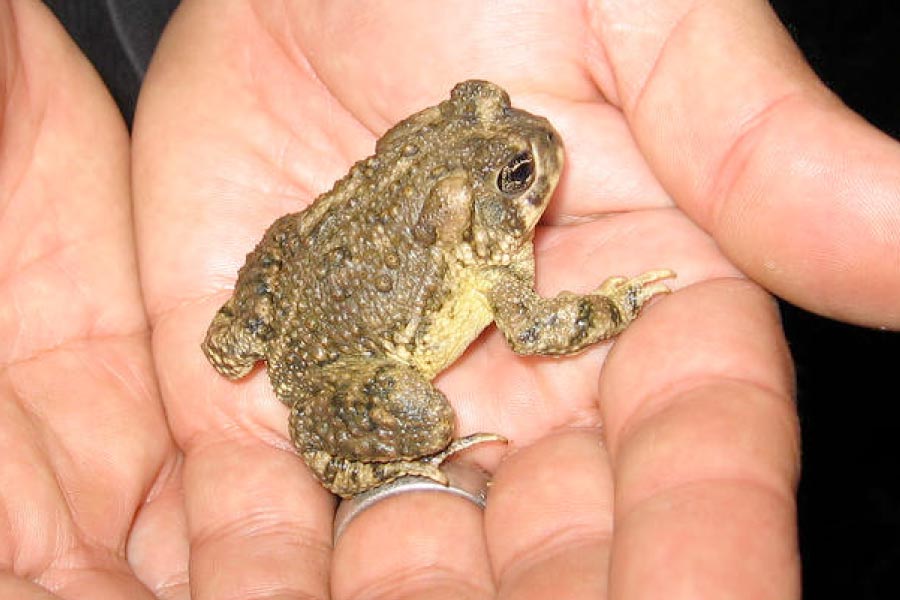
- Scientific name: Anaxyrus californicus
- Type of animal: Amphibian
- Where found: North America
The arroyo toad is found in California, U.S.A. and Baja California, Mexico, where it inhabits streams and washes (dry desert creeks that fill with water after rain). It is small (2-3 in. / 5-7.5 cm) and stockily-built, with pale, olive-green / grey skin.
Outside of the mating season, the arroyo toad spends much of the day buried in sand or mud, emerging at night to forage for ants and other small insects. During the dry season, it enters a state of dormancy known as aestivation.
Why are arroyo toads endangered?
The arroyo toad population currently consists of fewer than 3,000 individuals and continues to decrease. The species is endangered primarily due to habitat loss.
Asian Elephant

- Scientific name: Elephas maximus
- Type of animal: Mammal
- Where found: Asia
Asian elephants are the largest land animals in Asia, and the second-largest in the world (after the African bush elephant, another endangered species). A large male has a shoulder height of around 9 ft / 2.74 m, and weighs around 4 metric tonnes / 4.4 short tons (8,818.49 lb.).
Asian elephants have smaller ears and smoother skin than their African cousins. Only the males have tusks.
Why are Asian elephants endangered?
Asian elephants are endangered due to poaching (male elephants are targeted for their valuable ivory tusks) and habitat loss.
Atlantic Bluefin Tuna
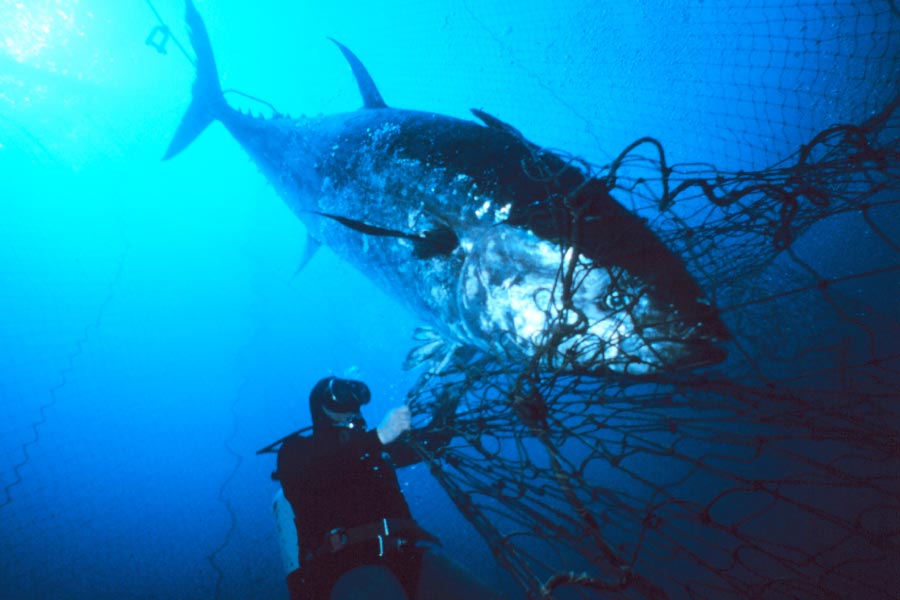
- Scientific name: Thunnus thynnus
- Type of animal: Fish
- Where found: Atlantic Ocean
The Atlantic bluefin tuna is a large fish found in the Atlantic Ocean. The species grows to lengths of up to 8.2 ft / 2.5 m and weights of around 680 kg / 1,500 lb. It preys on squid and fish, and some individuals are thought to live as long as 50 years.
Why are Atlantic bluefin tuna endangered?
The Atlantic bluefin tuna is a popular food fish and the primary cause of its endangered status is overfishing.
Aye-Aye
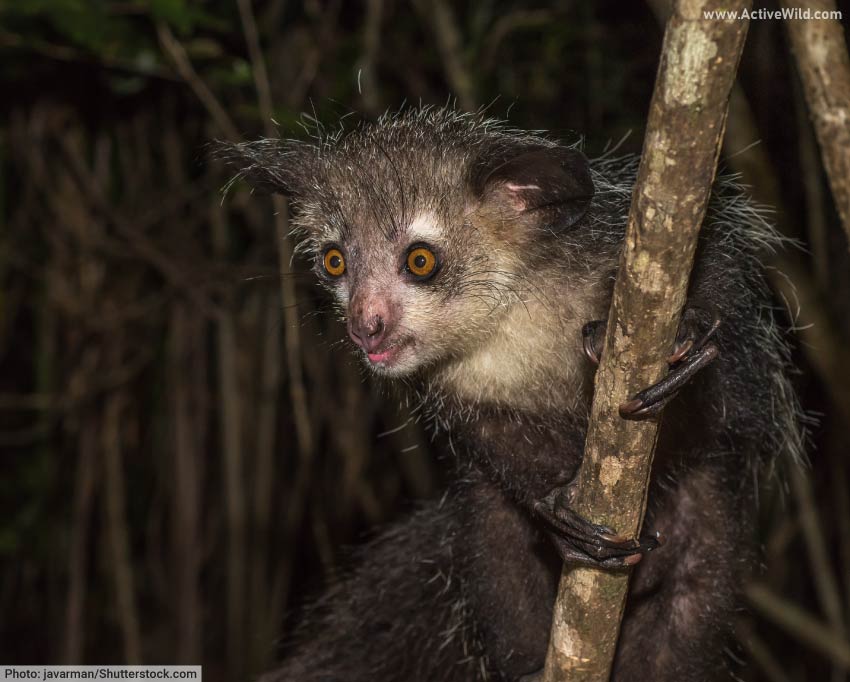
- Scientific name: Daubentonia madagascariensis
- Type of animal: Mammal
- Where found: Madagascar
The aye-aye is a species of lemur that lives in the rainforests of Madagascar, an island located in the Indian Ocean off the coast of East Africa.
The endangered mammal, which reaches a length of around 3 ft. (90 cm), including its long tail, is the world’s largest nocturnal primate.
The aye-aye finds food by tapping on trees with its fingers; it can tell by the sound if there’s an insect grub hidden beneath the bark.
Why are aye-ayes endangered?
Some local people believe that the aye-aye brings bad luck, and the species has faced persecution due to these beliefs. This, and habitat loss, are the main reasons that the aye-aye is endangered.
Barbary Macaque
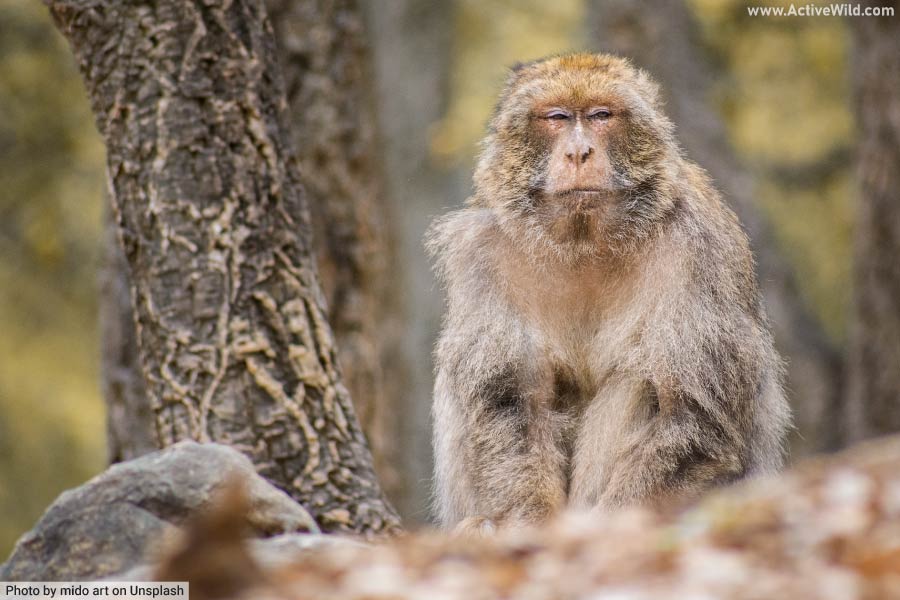
- Scientific name: Macaca sylvanus
- Type of animal: Mammal
- Where found: Africa, Gibraltar
A small colony of Barbary macaques lives in Gibraltar (a British territory on the southern coast of Spain), making the species the only monkey to be found in the wild in Europe. Barbary macaques are also found in northern Africa.
Unlike most other monkeys, the Barbary macaque lacks a tail. This has led to the species’ alternative name of “Barbary ape” (apes lack tails).
Why are Barbary macaques endangered?
In Africa, the Barbary macaque lives in high-altitude forests, and in Gibraltar, in rocky coastal areas. It is due to the loss of its African habitat that the monkey is endangered.
Basking Shark
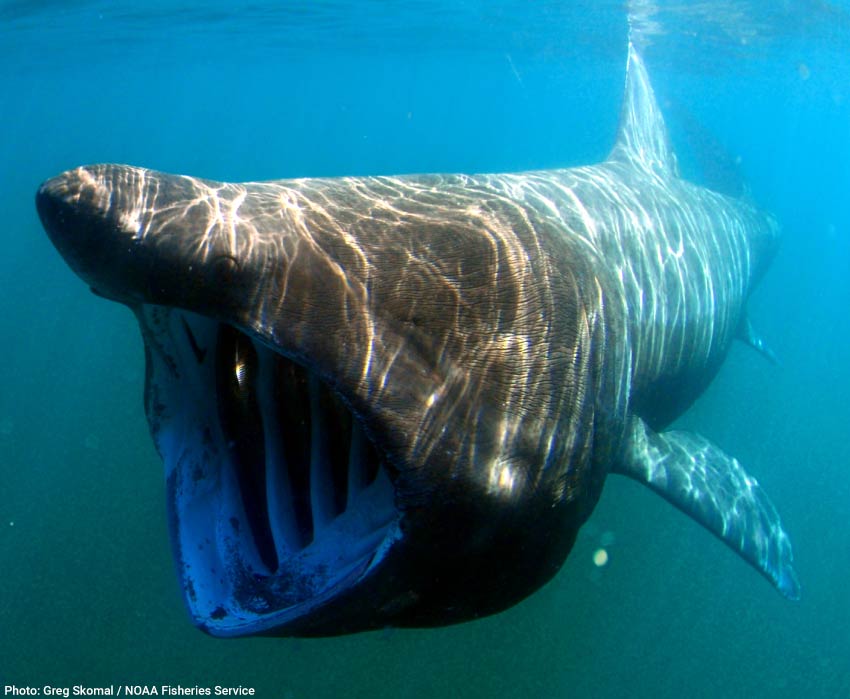
- Scientific name: Cetorhinus maximus
- Type of animal: Fish
- Where found: Oceans worldwide
The basking shark is the world’s second-largest fish. It grows to an average length of 26 ft / 7.9 m, but can reach lengths of up to 28 ft / 8.5 m; only the whale shark, another endangered species, is larger.
Unlike most sharks, the basking shark is a filter feeder rather than an active hunter. It swims through clouds of zooplankton (tiny ocean animals) with its large mouth held wide open, filtering the food from the seawater with comb-like projections from its gills known as “gill rakers”.
Why are basking sharks endangered?
The basking shark is endangered due to overfishing. Although the species is no longer targeted, it is still caught accidentally and, due to its surface-feeding habits, is occasionally struck by boats.
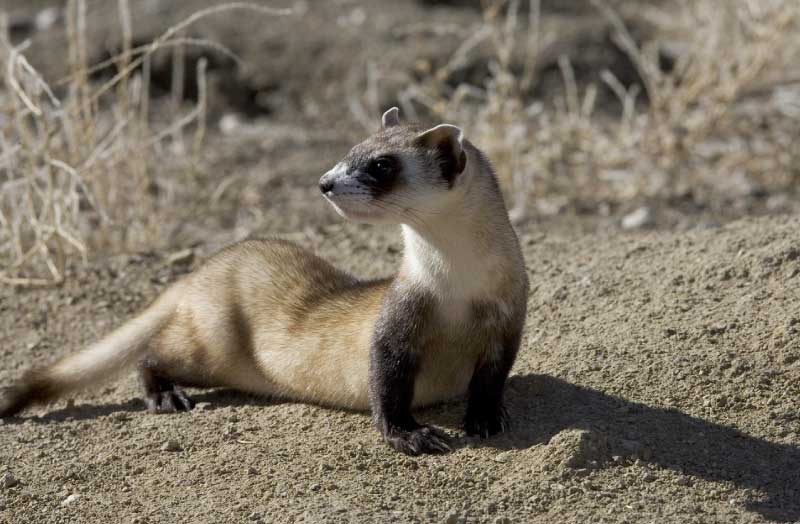
- Scientific name: Mustela nigripes
- Type of animal: Mammal
- Where found: North America
A list of endangered animals is not just about famous animals such as tigers and elephants; other, lesser-known species are also facing extinction.
The black-footed ferret is one such animal. Found in North America, it is a member of the family Mustelidae, which also includes weasels, badgers, the wolverine, and related animals.
In 1979 the black footed ferret was thought to be extinct in the wild, but in 1981 a small population was discovered in Wyoming.
A captive breeding program saw the species being reintroduced in several locations in North America.
Although several thousands of black footed ferrets have been reintroduced since the 1990’s, today’s wild population consists of just 206 adults.
Why are black-footed ferrets endangered?
Black-footed ferrets are endangered due to persecution of its main prey source, prairie dogs. The black-footed ferret’s fortunes are directly linked to the availability of these prey animals. Prairie dogs are capable of damaging crops, and were therefore persecuted by farmers. This, together with habitat loss, led to a fall in prairie dog populations, and a resultant decline in the black footed ferret population.
Black-Headed Spider Monkey
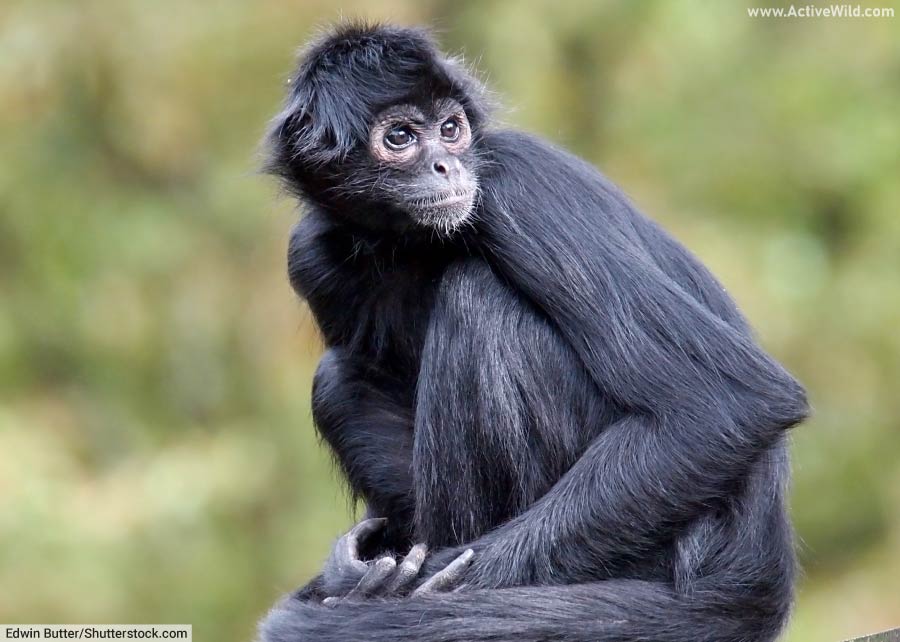
- Scientific name: Ateles fusciceps
- Type of animal: Mammal
- Where found: Central & South America
The black-headed spider monkey is an endangered monkey found in tropical and subtropical forests in Colombia, Ecuador and Panama.
The black-headed spider monkey has black or dark brown fur (it is also known as the brown-headed spider monkey). Like all spider monkeys it has extremely long limbs and a long, prehensile tail. (Prehensile means “able to grab”.) The tail is used like a “fifth hand” while the monkey is climbing.
Of the seven species of spider monkey, five (including the black-headed spider monkey) are endangered, one is critically endangered, and one is rated “Vulnerable”.
Why are black-headed spider monkeys endangered?
The black-headed spider monkey is endangered due to being hunted for food, and by the loss and fragmentation of its forest habitat.
Blue Speckled Tree Monitor
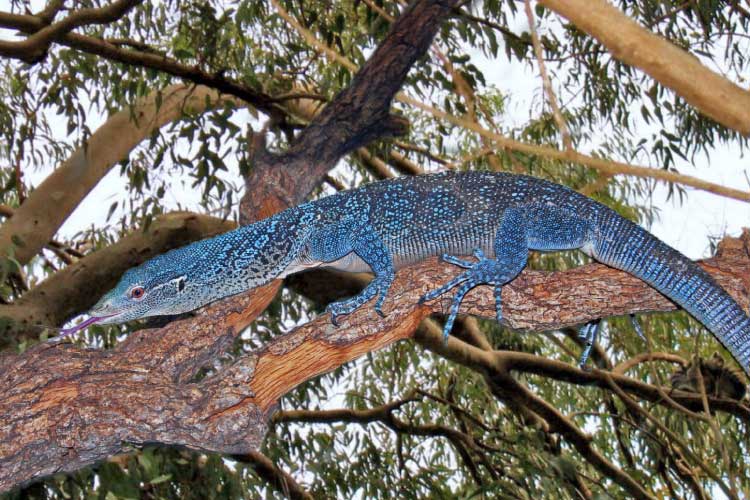
- Scientific name: Varanus macraei
- Type of animal: Reptile
- Where found: Asia
The blue-speckled tree monitor is a monitor lizard found only on Batanta island, part of the island country of Indonesia. The species, which is also known as the blue-spotted tree monitor, grows to around 3.5 ft (1.1 m) in length, and it is black with blue scale patterns.
Equipped with a long, prehensile tail that helps it climb, the blue-speckled tree monitor is largely arboreal (tree-living). It is found in tropical forests.
Why are blue-speckled tree monitors endangered?
The blue-speckled tree monitor is targeted by hunters who collect live specimens for sale to the pet trade. Deforestation is another threat to the species.
Blue Whale
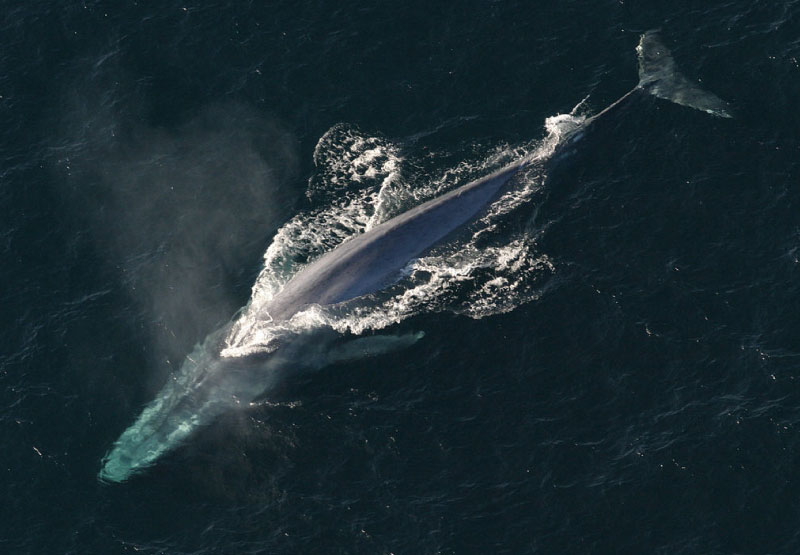
- Scientific name: Balaenoptera musculus
- Type of animal: Mammal
- Where found: Oceans worldwide
Blue whales are the largest animals ever to have lived on the Earth; they’re bigger than the biggest dinosaurs. Blue whales can weigh up to 200 tons, yet their diet consists almost entirely of tiny crustaceans called krill.
Why are blue whales endangered?
Blue whales are endangered due to historic overhunting. The species was once hunted almost to extinction. Today, the blue whale is protected worldwide and is making a slow recovery. However, with a population that currently numbers between 5,000 and 15,000 adult individuals, the blue whale remains an endangered species.
Bonobo
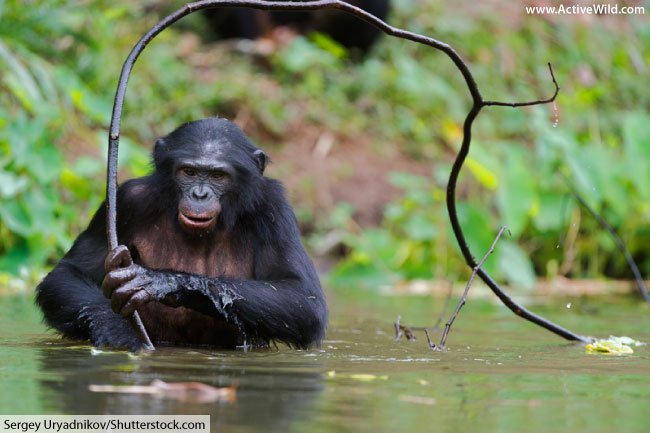
- Scientific name: Pan paniscus
- Type of animal: Mammal
- Where found: Africa
Bonobos are very similar to chimpanzees (both species belong to the genus Pan), but are usually slightly smaller, with longer legs and darker faces. Bonobos are found in the tropical forests of the Democratic Republic of Congo, Africa.
Why are bonobos endangered?
The bonobo is endangered due to poaching (hunting of the bonobo for bushmeat continues despite being banned) and habitat loss caused by logging and slash and burn agriculture.
- You can find out more about bonobos on this page: Bonobo Facts
Chimpanzee

- Scientific name: Pan troglodytes
- Type of animal: Mammal
- Where found: Africa
Chimpanzees are primates that live in the forests of central Africa. They are our nearest living relatives, sharing around 98% of our genes. They belong to the great ape family Hominidae, along with humans, bonobos, gorillas and orangutans.
These intelligent apes are among the very few animals known to use tools. Chimpanzees have been observed using sticks to extract insects such as termites and bees from their nests, and stones to crack open nuts.
Why are chimpanzees endangered?
The greatest threat to the chimpanzee is poaching; despite being protected, the species is targeted by hunters for its meat.
Dhole
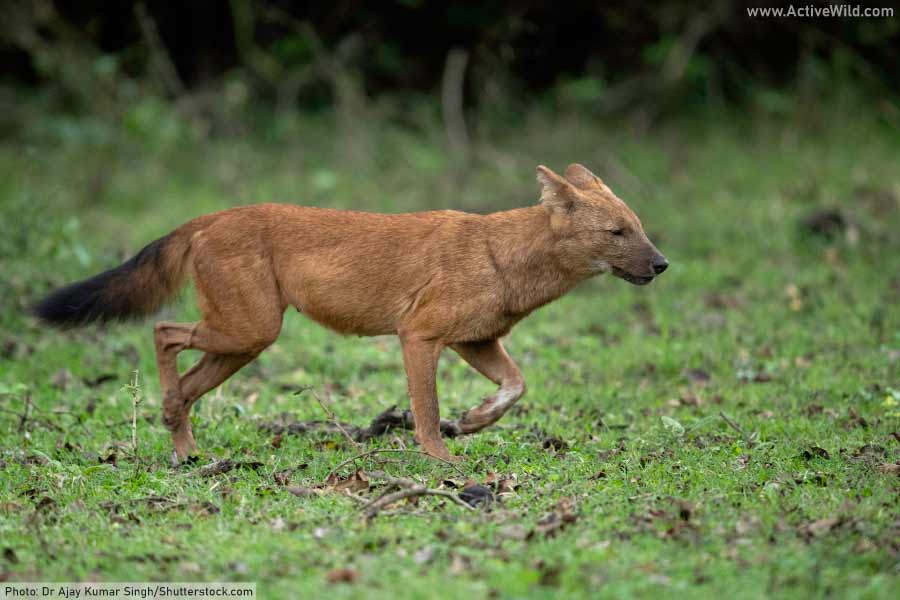
- Scientific name: Cuon alpinus
- Type of animal: Mammal
- Where found: Asia
Also known as the Asian wild dog, the dhole is a canid (member of the dog family, Canidae) found in several Asian countries, including India, Bangladesh and China, and also the islands of Sumatra and Java.
Despite its large range, the dhole’s population is thin and fragmented. The entire adult wild population of dholes is thought to number a maximum of 2,215 individuals.
Why are dholes endangered?
One of the main reasons that the dhole is endangered is competition with human hunters. Overhunting of the dhole’s natural prey by humans creates a scarcity of food for the dogs. Habitat loss has also played a large part in the species’ endangered status.
- You can find out more about dholes on this page: Dhole Facts
Egyptian Vulture
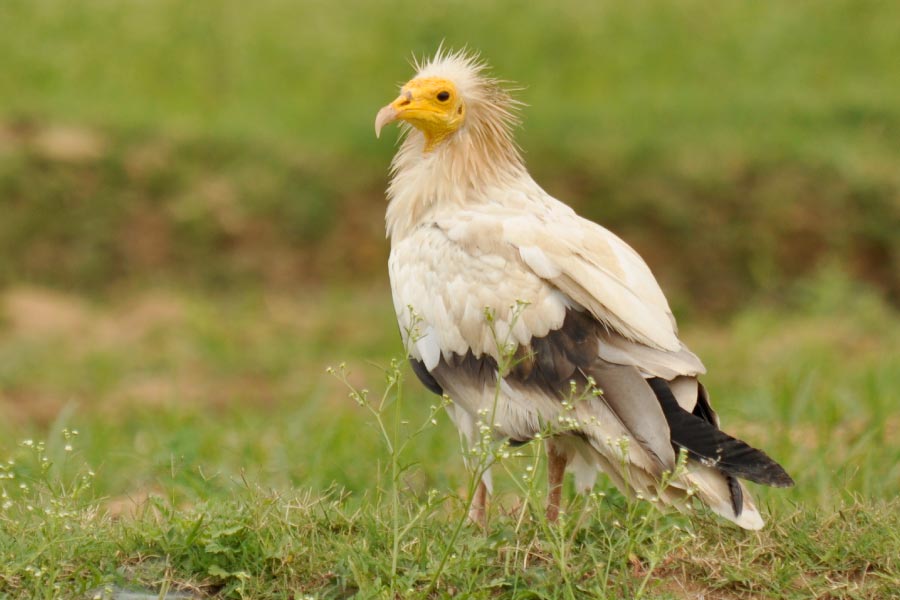
- Scientific name: Neophron percnopterus
- Type of animal: Bird
- Where found: Africa, Asia, Europe
The Egyptian vulture is found across a large part of southern Europe, northern Africa, and Asia. It is a striking bird with white plumage, a yellow face and a 5.58 ft. / 1.7 meter maximum wingspan.
Like most vultures, the Egyptian vulture is primarily a scavenger.
Why are Egyptian vultures endangered?
Today, much of the carrion eaten by the Egyptian vulture contains either poison or lead shot, which eventually proves fatal for the scavenger. In addition, drugs administered to livestock upon whose carcasses the vulture preys are harmful to the bird. Collisions with wind turbines and electrical cables also reduce the bird’s population.
Galápagos Penguin
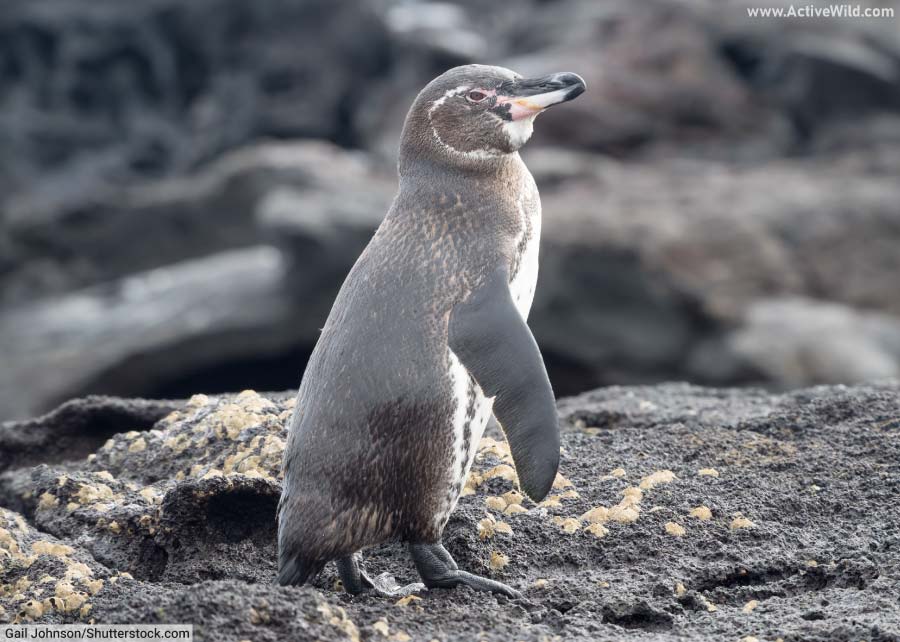
- Scientific name: Spheniscus mendiculus
- Type of animal: Bird
- Where found: Galápagos Islands
The Galápagos penguin is found on the Galápagos Islands, an island group in the Pacific Ocean 563 miles off the coast of Ecuador. The Galápagos penguin is the only penguin found north of the equator. It is the second-smallest penguin: only the little penguin is smaller.
Why are Galápagos penguins endangered?
The Galápagos penguin’s population is strongly affected by ENSO (the El Niño-Southern Oscillation), a cycle of warm and cold sea temperatures in the Eastern Pacific Ocean. In El Niño years, the water temperature rises, causing food to become scarce for the penguins.
- You can find out more about the penguins on this page: Penguin Facts
Galápagos Sea Lion
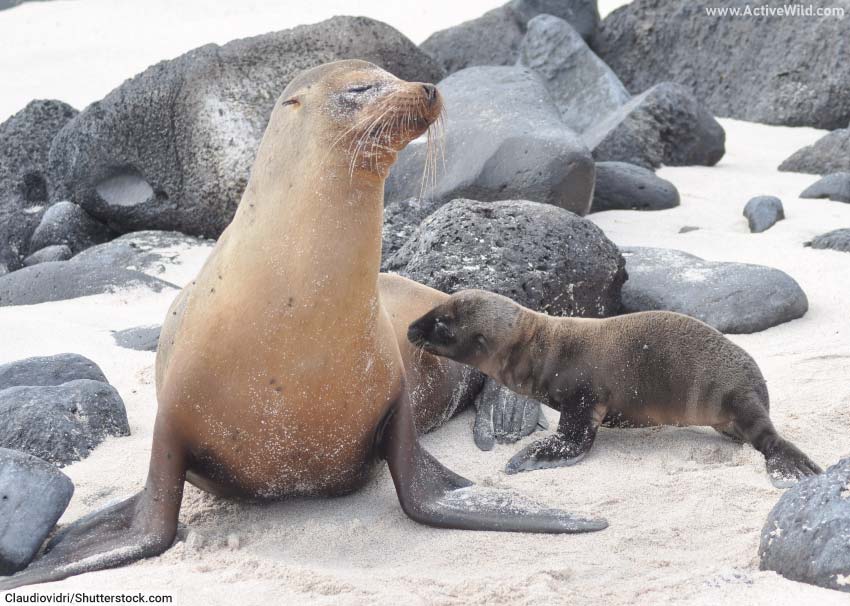
- Scientific name: Zalophus wollebaeki
- Type of animal: Mammal
- Where found: Galápagos Islands
The Galápagos sea lion lives on the coast of the Galápagos islands. It is the smallest sea lion species. There are only around 10,000 Galápagos sea lions left in the wild.
Why are Galápagos sea lions endangered?
Like the Galápagos penguin, the Galápagos sea lion is affected by El Niño events. These cause a reduction in the amount of available food and a resultant poor breeding season. Disease (possibly spread by dogs) also causes significant declines in the sea lion’s population.
Giant Abalone
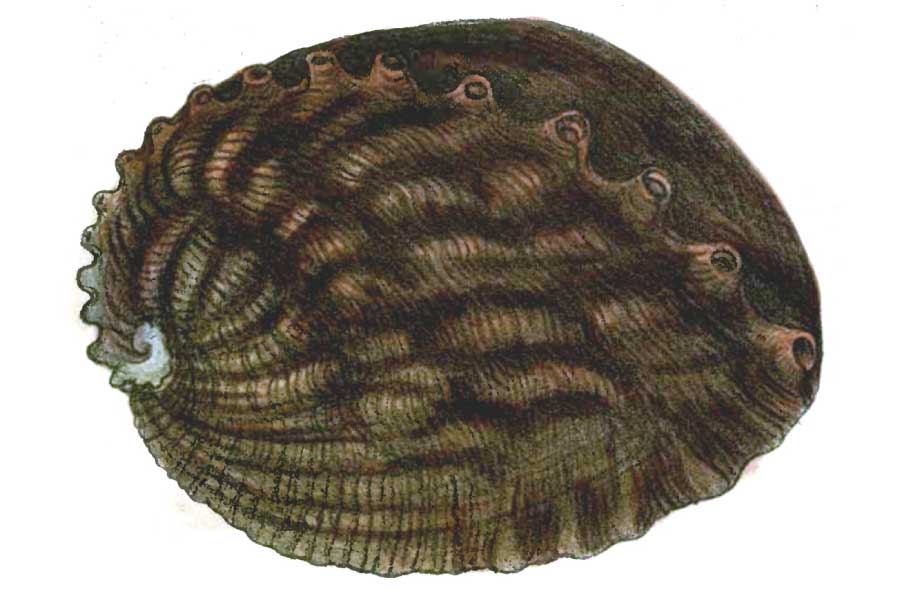
- Scientific name: Haliotis gigantea
- Type of animal: Mollusk
- Where found: Oceans surrounding Japan
The giant abalone is a sea snail found in the seas off of Japan and South Korea. It grows to a diameter of around 23.3 cm / 9.17 in. and, like all abalones, has a row of respiratory holes on its shell.
Abalones, like all sea snails, are mollusks belonging to the class Gastropoda. This group is home to all snails (including land-living varieties) and slugs.
Many abalones, including the giant abalone, are harvested for food, and overfishing is a principal cause of the species’ endangered status. The loss of the seaweed beds upon which the giant abalone is found is another contributing factor.
Giant Otter
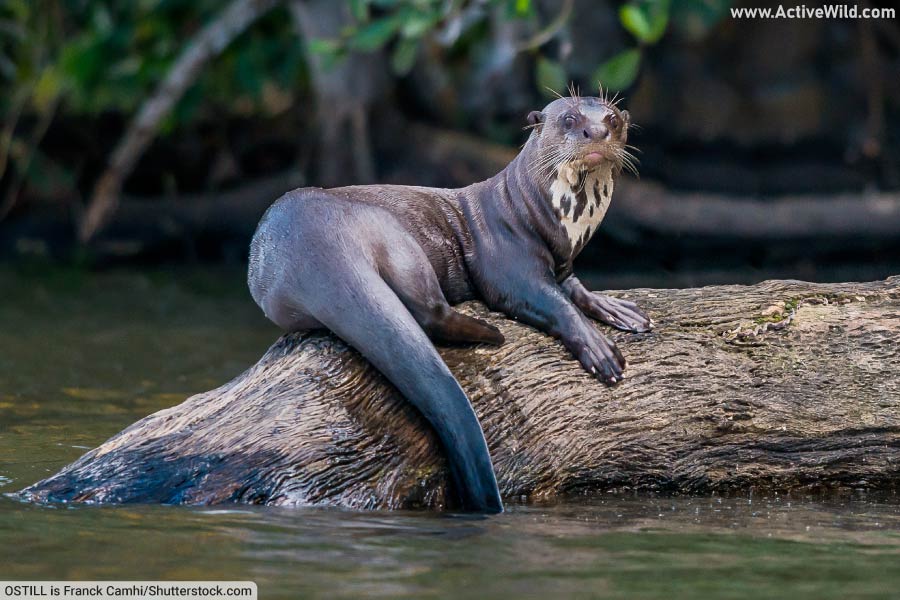
- Scientific name: Pteronura brasiliensis
- Type of animal: Mammal
- Where found: South America
The giant otter is a species of otter found in South America. It is present in the Amazon River and the Pantanal (a vast tropical wetland). Like other otters, it is a semi-aquatic hunter. Its diet consists almost entirely of fish.
As its name suggests, the giant otter is one of the larger otter species, reaching 1.8 m / 5 ft 11 in. in length. Like other otters, it is a member of the weasel family, Mustelidae.
Previously the victim of overhunting for its pelt, the giant otter today is threatened by human encroachment into its habitat, as well as by pollution and disease.
Golden Lion Tamarin
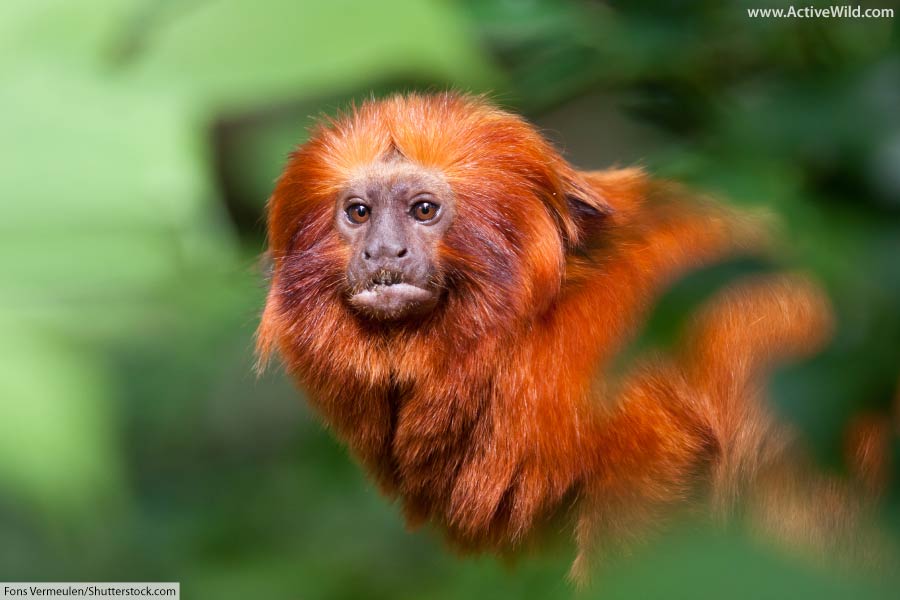
- Scientific name: Leontopithecus rosalia
- Type of animal: Mammal
- Where found: South America
The golden lion tamarin is a monkey that lives in Brazil’s Atlantic Coastal Forest.
The species belongs to a group of primates called the New World monkeys. This group split from the Old World monkeys around 40 million years ago. The nostrils of New World monkeys open to the sides, whereas those of Old World monkeys open downwards.
Why are golden lion tamarins endangered?
The primary cause of the golden lion tamarin’s endangered status is deforestation. Over 85% of the Atlantic Coastal Forest in which the monkey lives has been destroyed. In addition, the golden lion tamarin is hunted for sale to the pet trade.
Golden Poison Frog
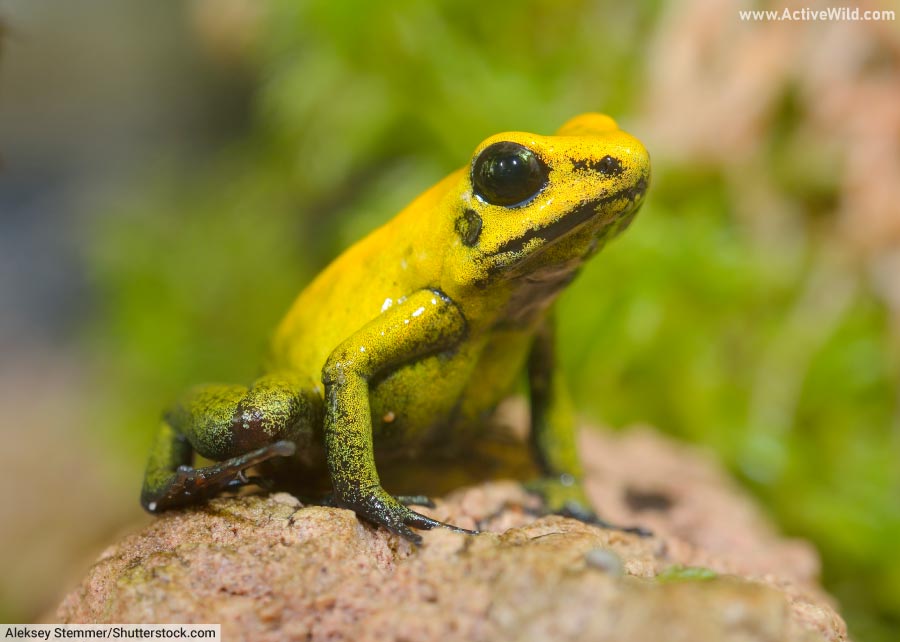
- Scientific name: Phyllobates terribilis
- Type of animal: Amphibian
- Where found: South America
The golden poison frog is a brightly-colored frog that lives in the rainforests of Colombia. It is the largest species of poison dart frog, reaching a length of 55 mm / 2.17 in. As well as its characteristic yellow, the species’ skin can also be green or orange in color.
The golden poison frog’s bright coloration warns potential predators that it is poisonous. The species is considered by many to be the world’s most poisonous vertebrate.
Why are golden poison frogs endangered?
Like many rainforest animals, the primary threat to the golden poison frog is deforestation.
Green Eyed Bushfrog
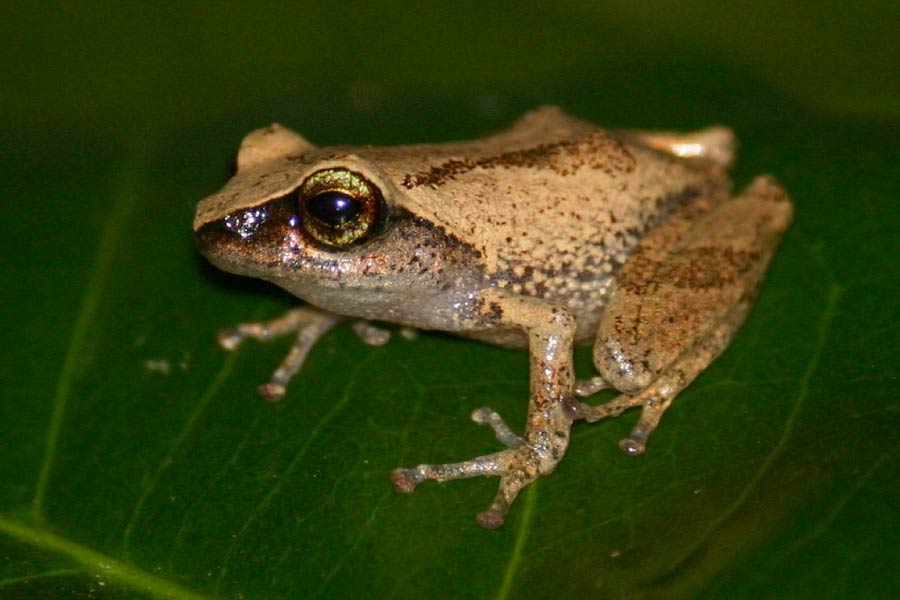
- Scientific name: Raorchestes chlorosomma
- Type of animal: Amphibian
- Where found: Asia
The green-eyed bushfrog is a critically endangered amphibian found in evergreen forests on the slopes of the Western Ghats mountain range in India.
Unlike many frogs, the green-eyed bushfrog (and other frogs of genus Raorchestes) skips the tadpole stage of its development, hatching directly from its egg as a frog.
Why Are Green Eyed Bushfrogs Endangered?
The green-eyed bushfrog is endangered due to habitat loss caused by plantations of crops such as tea and eucalyptus.
Green Sea Turtle

- Scientific name: Chelonia mydas
- Type of animal: Reptile
- Where found: Tropical and Subtropical Oceans Worldwide
The green sea turtle is one of seven living species of sea turtle, and one of six in the family Cheloniidae (the “odd one out” is the leatherback sea turtle, which is in the family Dermochelyidae).
The green sea turtle is found in tropical and subtropical waters all around the world. It is a migratory species, swimming between its feeding and nesting sites. These journeys take some individuals over 1,600 mi / 2,600 km.
Why are green sea turtles endangered?
Threats to the green sea turtle include the harvesting of both eggs and turtles by humans from the turtle’s nesting grounds, and the accidental capture of turtles in nets and long lines meant for fish.
Human development of the turtle’s traditional nesting sites has also played a part in the green sea turtle’s endangered status.
Grey Parrot
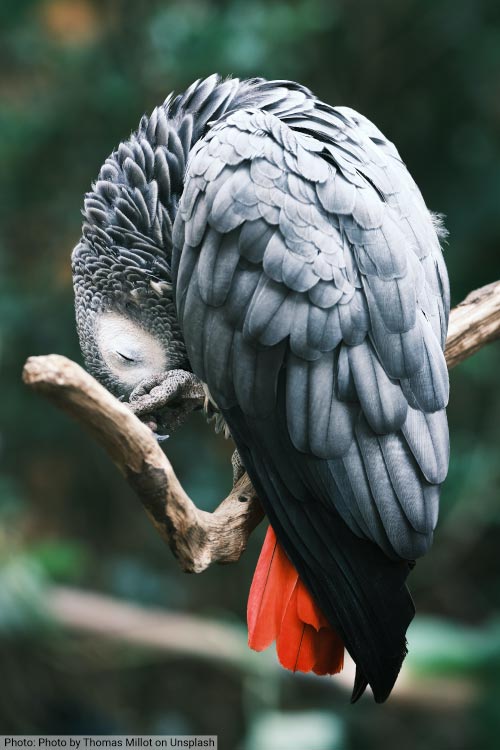
- Scientific name: Psittacus erithacus
- Type of animal: Bird
- Where found: Africa
The grey parrot, despite being a popular pet, is endangered in the wild. The species is found in tropical forests in Africa. It is primarily frugivorous (fruit-eating).
The grey parrot is one of the most intelligent birds, and is able to mimic the human voice and other environmental sounds.
Why are grey parrots endangered?
The primary threat to the grey parrot is the capture of wild birds for sale to the pet industry. Deforestation is also playing a part in the bird’s decline.
Humphead Wrasse
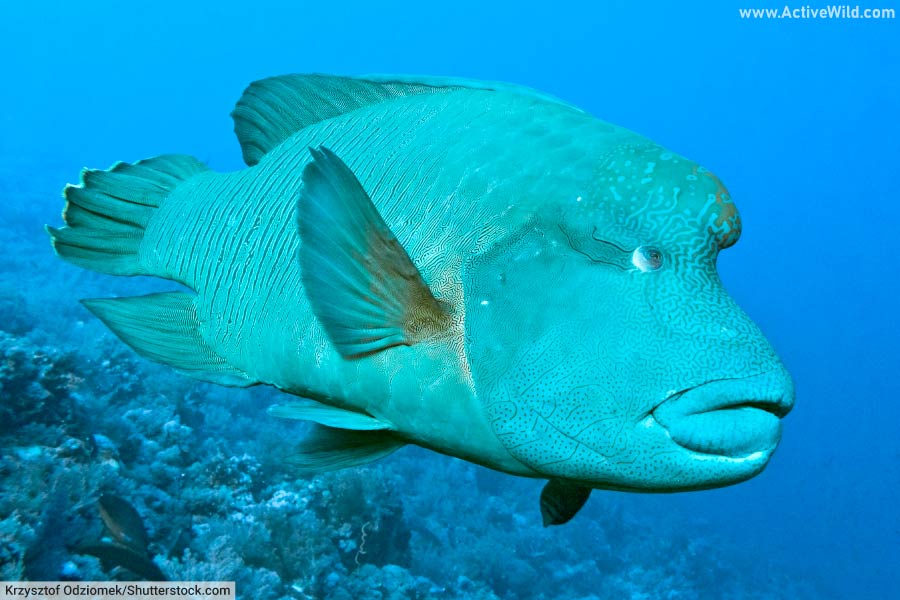
- Scientific name: Cheilinus undulatus
- Type of animal: Fish
- Where found: Indo-Pacific
The humphead wrasse is a coral reef fish that lives in the Indo-Pacific (an area that combines the Indian Ocean, and the western and central Pacific Ocean).
Male humphead wrasses grow to lengths of up to 6.56 ft / 2m; females are substantially smaller. Like all wrasses, some females – usually the largest – turn into males. This process is known as “protogynous hermaphroditism”.
The humphead wrasse’s “hump” – the bulge on its forehead – gets bigger as the fish gets older.
Why are humphead wrasses endangered?
The humphead wrasse is considered a delicacy in several Asian countries and is heavily hunted as a result.
Majorcan Midwife Toad
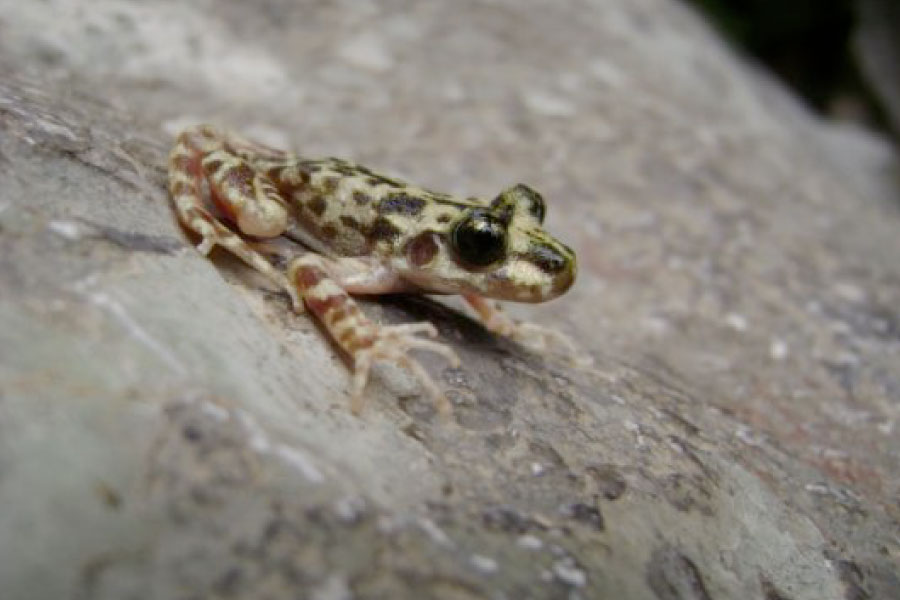
- Scientific name: Alytes muletensis
- Type of animal: Amphibian
- Where found: Majorca
The Majorcan midwife toad is an endangered amphibian found only on the Spanish island of Majorca in the Mediterranean Sea.
After fertilizing strings of eggs produced by the female, the male Majorcan midwife toad carries them on his back for protection. When the eggs are ready to hatch, he deposits them in a suitable body of shallow water. The Majorcan midwife toad is one of several species of “midwife” toads in which this behavior is seen.
Why are Majorcan midwife toads endangered?
The main threat to the Majorcan midwife toad is competition from non-native species that have been introduced to the island. These include the Viperine Snake (Natrix maura) and Perez’s Frog (Rana perezi).
Marine Otter

- Scientific name: Lontra felina
- Type of animal: Mammal
- Where found: South America
The marine otter is one of two otters found in saltwater habitats, the other being the sea otter. Whereas the sea otter is almost fully aquatic, spending much of its life in the sea, the marine otter is semi-aquatic, dividing its time between the land and water.
One of the smallest otters, the marine otter reaches lengths of up to 115 cm / 43.3 in. It lives on the shore in areas with abundant seaweed, and prefers rocky areas with caves for shelter.
The main threat to the marine otter is habitat loss due to urban development of its habitat and competition with small-scale fisheries for food.
Okapi
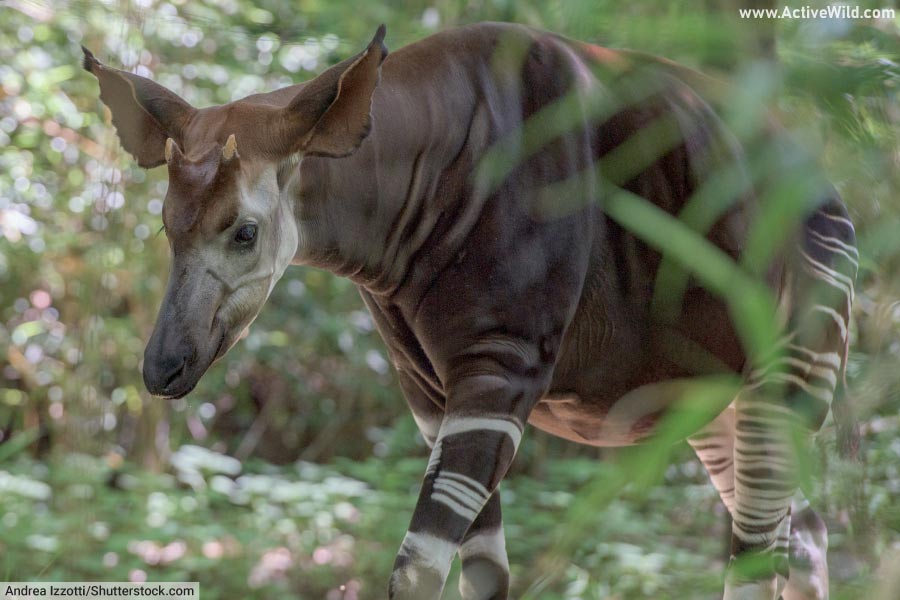
- Scientific name: Okapia johnstoni
- Type of animal: Mammal
- Where found: Africa
The okapi lives deep in the rainforests of Democratic Republic of the Congo, a country in central Africa.
Despite looking like a cross between a zebra and a deer, the okapi is actually one of two species in the family Giraffidae. The other species in the family, and the okapi’s closest relation in the animal kingdom, is the giraffe.
The stripes on an okapi’s legs and hind quarters act as camouflage, helping to break up the okapi’s outline as it moves through trees and foliage.
Why are okapis endangered?
The main threat to the okapi is deforestation. The species is also hunted for its meat and skin.
- You can find out more about the okapi on this page: Okapi Facts
Puritan Tiger Beetle
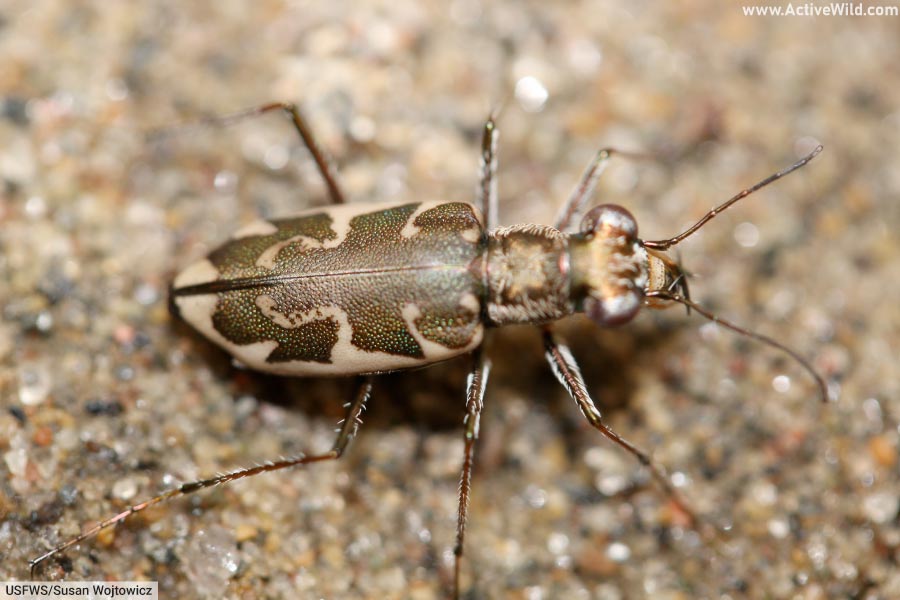
- Scientific name: Cicindela puritana
- Type of animal: Insect
- Where found: North America
The puritan tiger beetle is a species of tiger beetle found in a limited number of locations along the Chesapeake Bay and Connecticut River in the northwestern United States.
Tiger beetles are beetles in the subfamily Cicindelinae. They are known for their predatory habits and ability to run at high speeds.
Why are puritan tiger beetles endangered?
The puritan tiger beetle’s population is threatened by natural changes and human disturbance to its natural habitat.
Queen Alexandra’s Birdwing
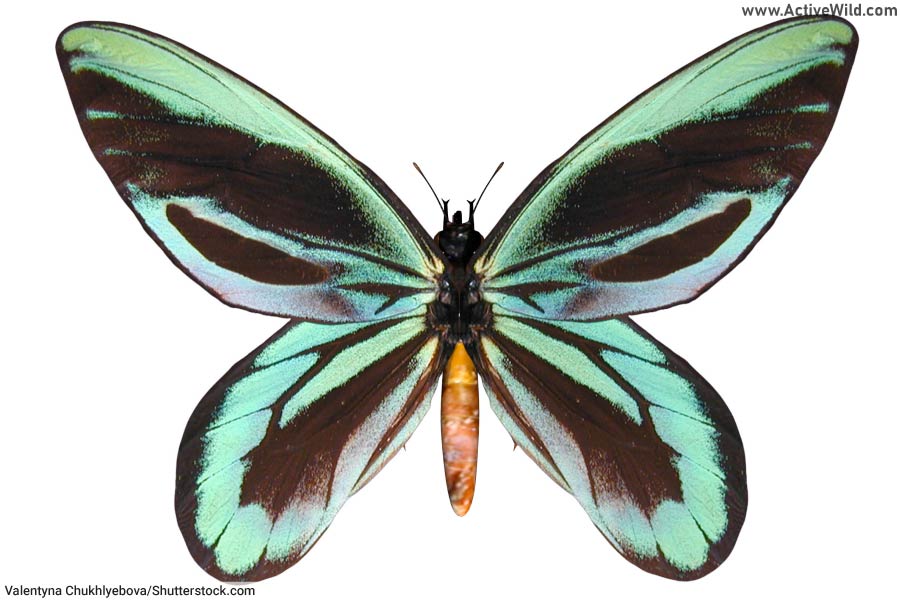
- Scientific name: Ornithoptera alexandrae
- Type of animal: Insect
- Where found: Asia
The Queen Alexandra’s birdwing is the world’s largest butterfly species. The female, which is larger but less colorful than the male, has a maximum wingspan of around 11 in. / 28 cm.
This endangered butterfly is found only in the rainforest of the Oro Province in Papua New Guinea. It was discovered by English naturalist Albert Stewart Meek, and named after Alexandra of Denmark, wife of King-Emperor Edward VII of Britain.
Why is the Queen Alexandra’s birdwing butterfly endangered?
The Queen Alexandra’s birdwing has become endangered due to deforestation. The forests in which it is found are being destroyed to make way for plantations of crops such as oil palm.
Red Hills Salamander
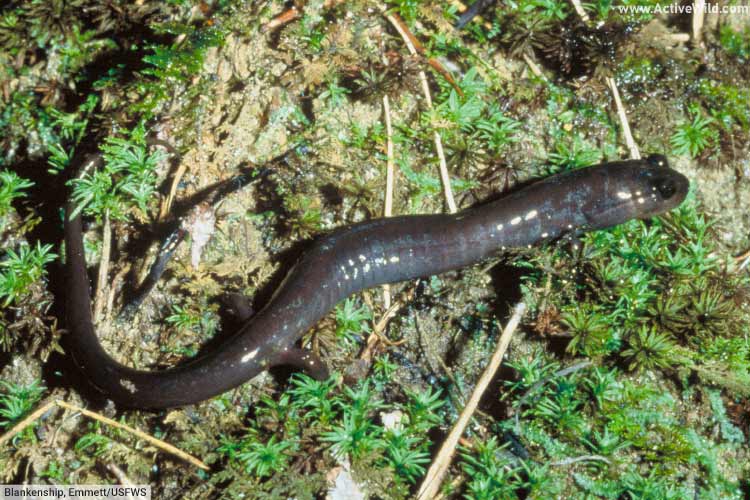
- Scientific name: Phaeognathus hubrichti
- Type of animal: Amphibian
- Where found: North America
Found in only two small regions of Alabama, United States, the Red Hills salamander is a mid to large gray/brown salamander that grows to lengths of around 10 in / 25.4 cm. The species is the state amphibian of Alabama.
Why are Red Hills salamanders endangered?
The Red Hills salamander is found mainly on land owned by private timber companies. Forestry techniques used by the companies are often detrimental to the species.
Projects aimed to reverse the amphibian’s decline include acquisition of land by The Nature Conservancy, an American non-profit organization. (Source)
Red Panda
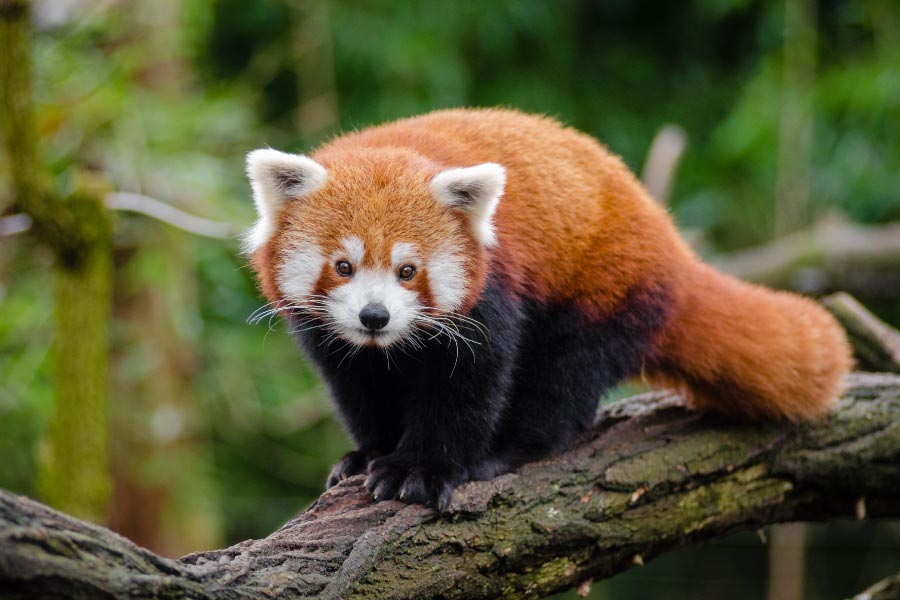
- Scientific name: Ailurus fulgens
- Type of animal: Mammal
- Where found: Asia
The red panda is found in temperate forests on the slopes of the Himalayas in Asia. Despite its name, the red panda is not a bear; its closest relatives in the animal kingdom are the mustelids (members of the weasel family).
The red panda mainly eats bamboo, supplementing its diet with other plant material and small animals and eggs. Due to its low-energy bamboo-based diet, the red panda spends most of its life either eating or sleeping.
Why are red pandas endangered?
The main threat to the red panda is habitat loss, due to a growing human population in its natural habitat, and deforestation.
Sea Otter

- Scientific name: Enhydra lutris
- Type of animal: Mammal
- Where found: North Pacific Ocean
The sea otter is the heaviest mustelid (member of the weasel family Mustelidae) but one of the smallest marine mammals. It has the thickest fur of any animal. It relies on its fur for insulation, as, unlike most other marine mammals, it lacks a layer of blubber.
The sea otter is known for its rafting behavior, in which between 10 and 100 sea otters float on their backs on the surface of the ocean, often anchoring themselves to kelp to prevent themselves from drifting.
Why are sea otters endangered?
Threats to the sea otter include oil spills and accidental capture in fishing nets.
Secretarybird
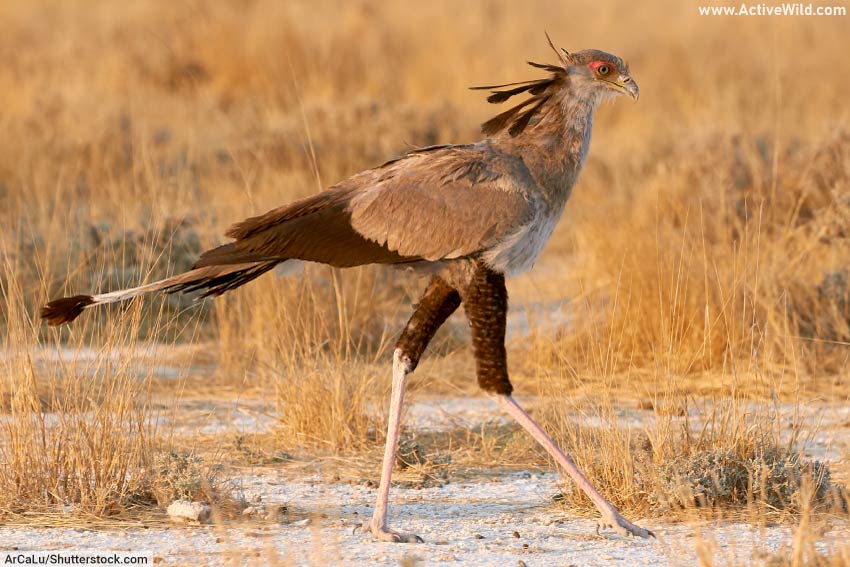
- Scientific name: Sagittarius serpentarius
- Type of animal: Bird
- Where found: Africa
The secretarybird (also known as the secretary bird) is a large, long-legged bird of prey found in grasslands and savannas in sub-Saharan Africa. Although it can fly, the species is mainly terrestrial (land-living). It spends most of the day on the ground and roosts in trees at night.
The secretarybird hunts on foot. Its prey includes insects and small vertebrates, including mice, mongooses and lizards. The secretarybird is famous for its ability to prey on venomous snakes such as cobras and adders.
Why are secretarybirds endangered?
Like many endangered animals, the main threat to the secretarybird is habitat loss caused by farming and urbanization.
South Asian River Dolphins
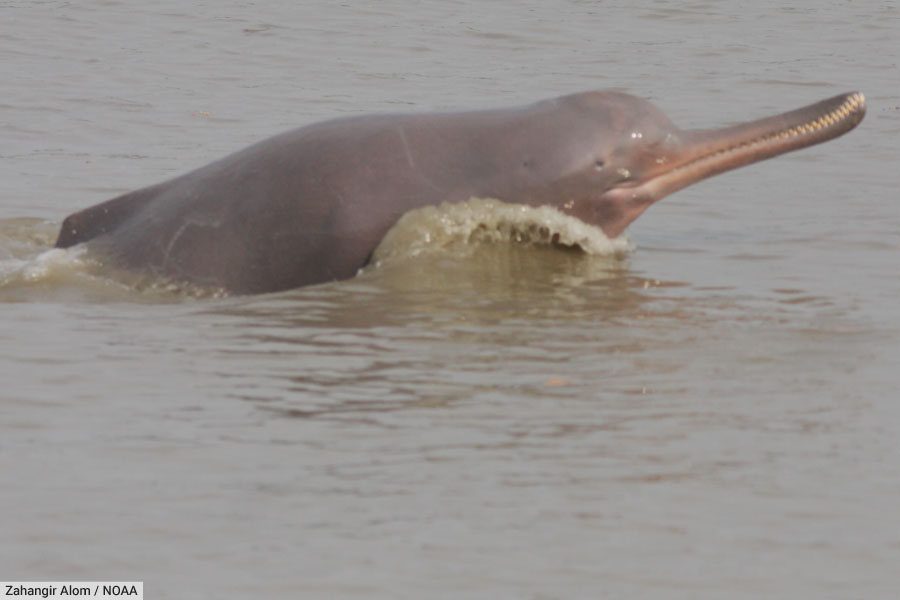
- Scientific name: Platanista gangetica (Ganges River dolphin); Platanista minor (Indus River dolphin)
- Type of animal: Mammal
- Where found: Asia
Previously considered to be subspecies of a single species, the Ganges River dolphin (Platanista gangetica) and Indus River dolphin (Platanista minor) are now considered to be separate species. Both species of South Asian river dolphins are endangered.
Like other cetaceans (the animal group that is home to all whales, dolphins and porpoises) Asian river dolphins are aquatic mammals, although unlike most other members of this group, south Asian river dolphins live in freshwater, rather than marine, habitats.
The south Asian river dolphins are almost entirely blind (although their eyes may be able to detect changes in light) and hunt using echolocation. (The murky waters in which the dolphins live deem normal eyesight unnecessary.)
Why are south Asian river dolphins endangered?
Dams and other manmade obstructions in the rivers in which South Asian river dolphins live have caused the species’ populations to become fragmented. The structures have also had a negative effect on the dolphins’ habitat and food supply. Pollution and gillnetting are additional factors in the species’ endangered status.
Southern Plains Bumblebee
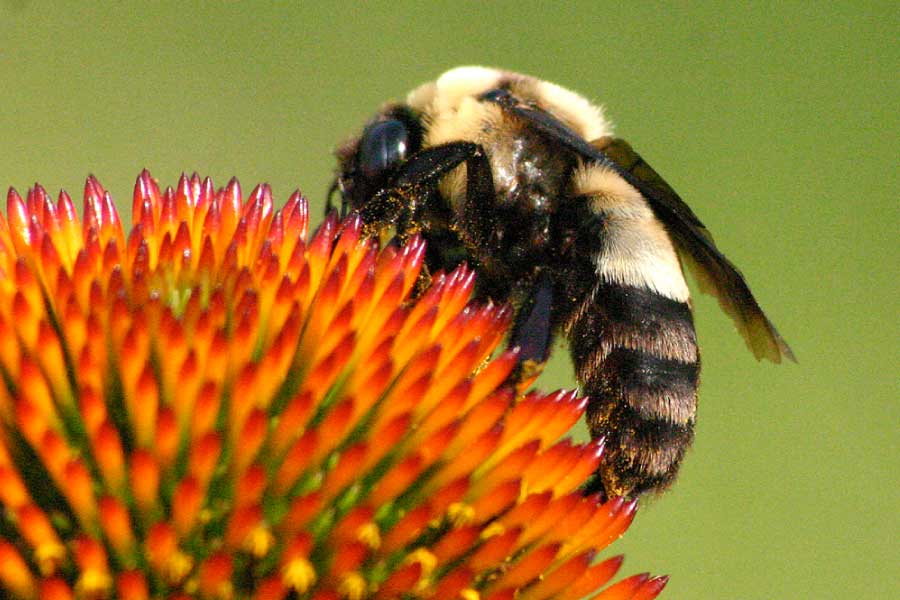
- Scientific name: Bombus fraternus
- Type of animal: Insect
- Where found: North America
The southern plains bumblebee is an endangered bumblebee species found in the southeastern United States. It can be identified by the black band at the rear of its mainly pale yellow thorax, the pale yellow and black coloration of the front and rear of its abdomen respectively, and the “flat”, rather than “fluffy” appearance of its short hair.
Plants on which the southern plains bumblebee feeds on include milkweeds, prairie clovers, cassias and blazing stars.
Why are southern plains bumblebees endangered?
The main threat to the southern plains bumblebee is the conversion of its native grassland habitat into fields for crops.
Tasmanian Devil
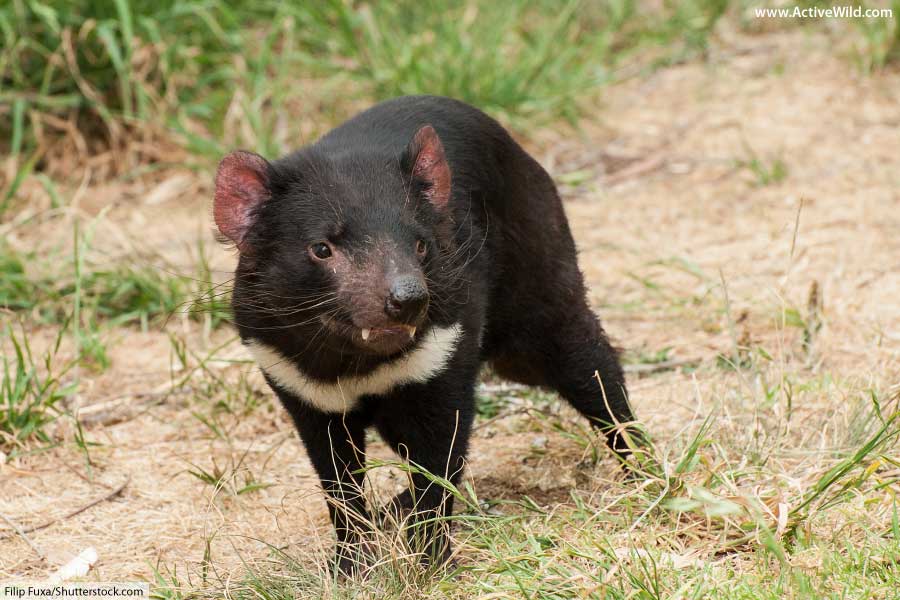
- Scientific name: Sarcophilus harrisii
- Type of animal: Mammal
- Where found: Australia
The Tasmanian devil is the world’s largest carnivorous marsupial. It is a member of the family Dasyuridae, which also contains the quolls and other mainly carnivorous / insectivorous marsupials.
Most wild Tasmanian devils are found on the Australian island state of Tasmania. A small number have recently been reintroduced onto the Australian mainland.
The Tasmanian devil gets its name for its terrifying night-time screeches and aggressive feeding behavior.
Why are Tasmanian devils endangered?
The Tasmanian devil is endangered due to the spread of Devil Facial Tumor Disease (DFTD), which has caused a large decline in the species’ population.
Tiger
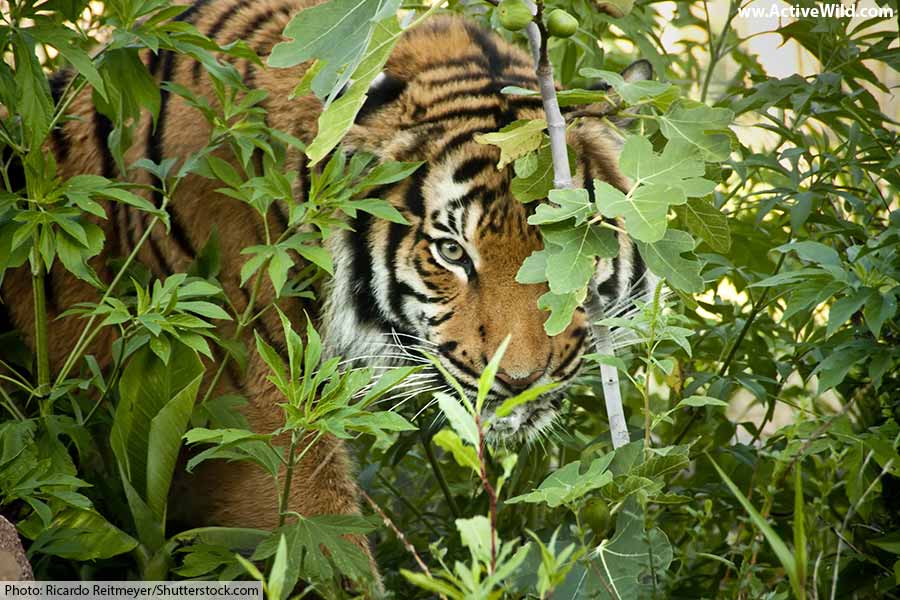
- Scientific name: Panthera tigris
- Type of animal: Mammal
- Where found: Asia
The tiger is the largest member of the cat family Felidae. Despite being one of the world’s most recognizable animals, the tiger’s wild population consists of under 3,200 adult individuals. Most wild tigers are found in southern Asia, although a separate population exists in Siberia.
Tigers are able to live in a wide range of habitats, including both tropical and boreal forests.
Why are tigers endangered?
The tiger is endangered primarily due to poaching and deforestation. Despite its protected status, the tiger is still illegally hunted, both for its hide and for other body parts, which are used in traditional Asian medicine.
Tiger Chameleon
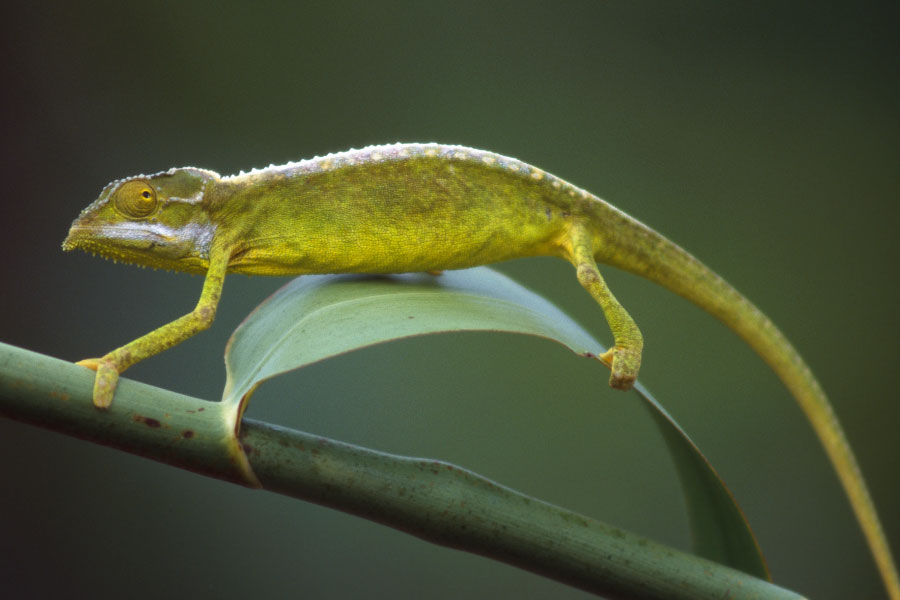
- Scientific name: Archaius tigris
- Type of animal: Reptile
- Where found: The Seychelles
The tiger chameleon is an endangered reptile found only on the Seychelles, an African island country in the Indian Ocean. The species is around 6.3 in / 16 cm in length, and has a distinctive cluster of spiky growths on its chin. It hunts insects using its extendable sticky tongue.
Why are tiger chameleons endangered?
The main threat to the tiger chameleon is the introduction of the non-native tree, Cinnamomum verum, which is dominating native species.
Whale Shark
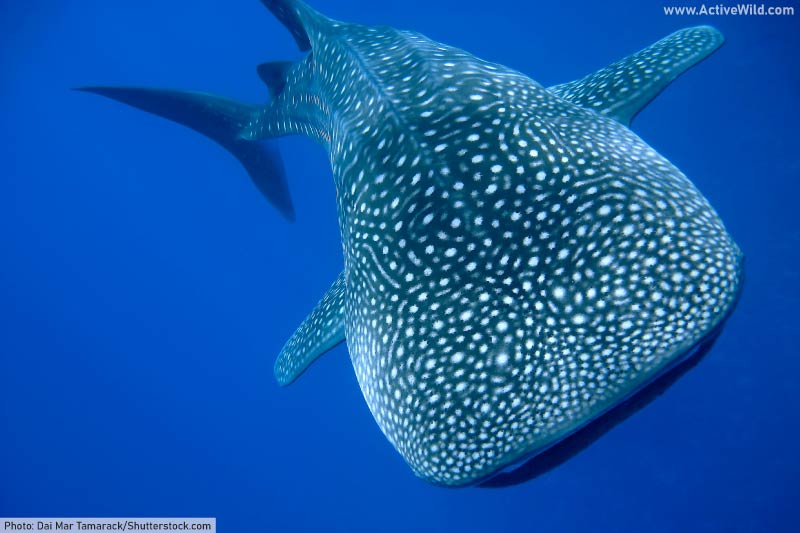
- Scientific name: Rhincodon typus
- Type of animal: Fish
- Where found: Tropical oceans worldwide
The whale shark, which reaches lengths of up to 62 ft. / 18.8 m, is the world’s largest fish species.
Unlike all but two of the over 500 other species of sharks, the whale shark it is a filter feeder. (The other two filter-feeding sharks are the basking shark, which is also endangered, and the megamouth shark, which is not currently threatened.)
Despite its great size, the whale shark diet consists of plankton – small organisms that drift in the water.
The whale shark is usually found near the surface of the ocean, but is known to dive to depths of 1.2 miles / 1.928 km.
Why are whale sharks endangered?
The whale shark is endangered due to hunting (both targeted and accidental). It is also the victim of vessel strikes.
Whooping Crane
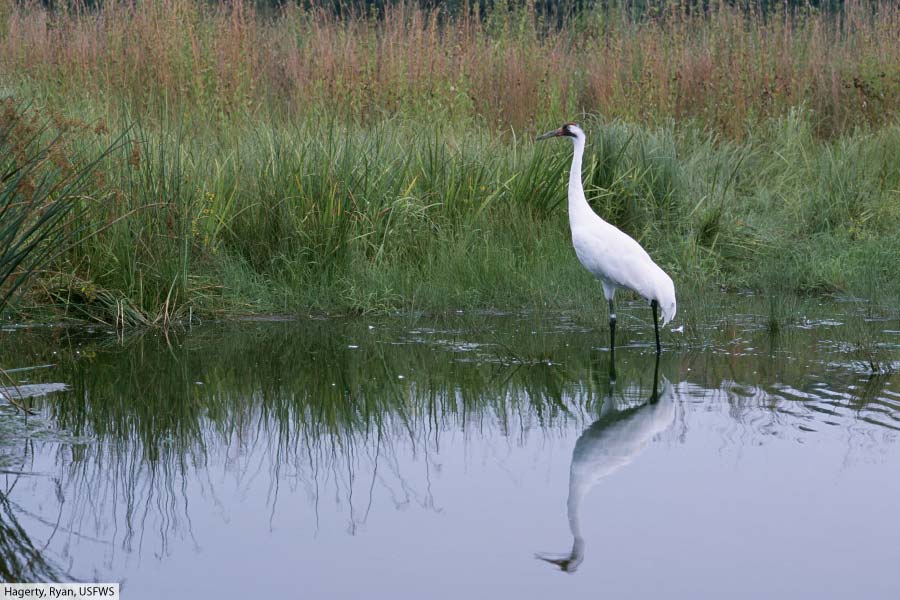
- Scientific name: Grus americana
- Type of animal: Bird
- Where found: North America
The whooping crane is a long-necked, long-legged bird whose white plumage distinguishes it from the much more common sandhill crane (whose plumage is generally grey-brown). It is the tallest, and one of the heaviest, birds of North America.
The wild population of whooping cranes currently numbers around 250 adult individuals (due to recent breeding successes this number may actually be substantially larger). Most spend summers in Canada’s Wood Buffalo National Park, and overwinter in wetlands in Texas, USA.
The species is named for its extremely loud whooping call.
Why are whooping cranes endangered?
The whooping crane became an endangered species due to overhunting and habitat loss. Today its recovery is affected by collisions with powerlines, drought and development of its natural habitat.
Endangered Animals List: Conclusion and Credits
Sources of information for this page include the International Union for Conservation of Nature (website) and the IUCN RedList.

